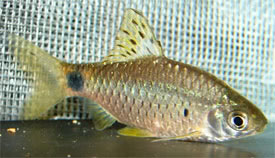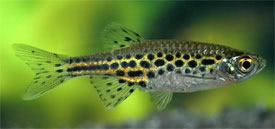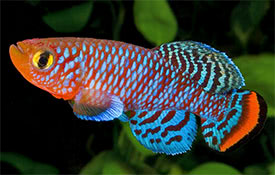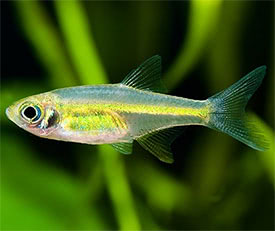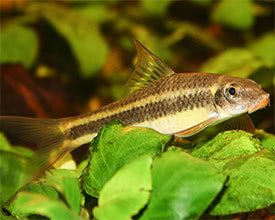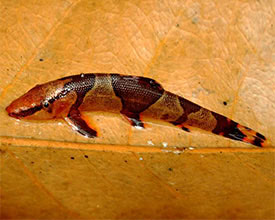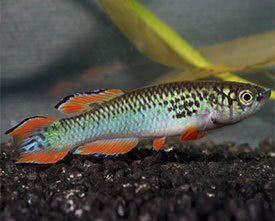
 Magyarul / Hungarian
Magyarul / Hungarian
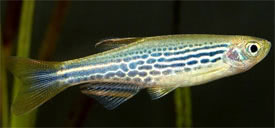


- Scientific name: Brachydanio kyathit
- Synonyms: Danio kyathit
- Common name: Orange-Finned Danio
- Group: Cyprinids
- Habitat: Asia; North Myanmar (Burma)
- Size: 4-5 cm
- Biotope: Inhabits in smaller, fast-flowing streams in calmer, marginal zones. These streams have dense marginal bamboo growth with a lot of shade.
- Social behavior: A peaceful and active shoaling fish, ideal for community tanks.
- Diet: Omnivorous; in nature they mainly eat insects and insect larvae. In the aquarium they accept everything: live, frozen and flake foods too.
- Breeding: Quite easy
- Tank: Minimum 60 litres
- Population: 8-10 fish for 80 litres
- Decoration: They deserve a heavily-planted tank with a dark substrate. Decorate the aquarium with some bogwood. Cover their tank, as they are good jumpers.
- Temperature: 20-26 °C
- pH: 6.5-7.5
- Hardness: 2-10 NK°
- Lifespan: 3-5 years
Description: Danio kyathit can have variable body patterning: there are 5-7 dark, spotted or continuous horizontal stripes on the side of the body. Orange-Finned Danio has two pairs of long barbels. At first look it is very similar to Danio rerio, but possesses much longer barbels and has red or orange finnage, as well as in Danio rerio all 5 dark body stripes continue into the caudal fin, while in Danio kyathit only the middle stripes (1-3) extend to the tip of the caudal-fin. In 2012 it ascertained in a DNA barcode analysis that they are genetically distinct (by Collins). Mature females are a little larger and plumper, but not as colorful as males. The differences are especially clear when the fish are in spawning condition.
Orange-Finned Danios are egg-scatteres. It is possible that a small numbers of fry survive in a densely planted community tank, but it is best to spawn them in a separated, 30-40 litres aquarium. Fill up the tank to the half with 25-26 °C water, and use dim lighting. Add some java moss or spawning grid to the breeding tank, to protect the eggs. A small water-flow in the full length of the tank is advisable, so an internal power filter should be added to the tank. Place the fish to the breeding tank in the evening, and they should spawn in the following morning. Spawning can be initiated by adding small amounts of cool water every few hours. After spawning the parents should be removed, otherwise they will eat the eggs. After spawning change the power filter to a sponge filter to avoid fry being sucked into the filter. Incubation is temperature-dependant, and the eggs hatch after 24-36 hours, and become free-swimming after a few days. Feed the young fish with infusoria or Artemia nauplii.






































